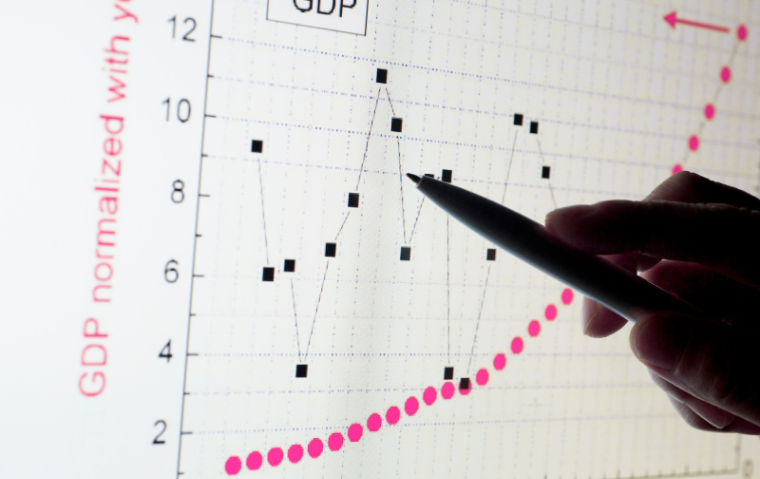Czech economy grew by one percent last year
Economic commentary by Jaromir Šindel, Chief Economist of the CBA

The Czech economy ended 2024 with quarter-on-quarter GDP growth of 0.5%, in line with market expectations. Nevertheless, this figure comes as a positive surprise given the available data on economic activity for October and November. Annual GDP growth thus accelerated slightly to 1.6% in the fourth quarter. For the full year 2024, however, the economy grew more slowly on average, namely by 1% yoy after a weak 0.1% recovery in 2023 (yoy impact of the energy crisis).
This year, economic growth is likely to be below 2% y/y, depending on several factors. Household consumption, supported by real wage growth and falling interest rates, and investment activity driven by fiscal policy and European funds are likely to play a key role. On the other hand, weak industrial production is likely to continue to dampen growth.
Within the region, Czech GDP growth performed similarly to Hungary, which returned to 0.5% q-o-q growth after two quarterly declines. However, it still lags behind Poland, whose GDP probably grew at a rate of over 2.5% q-o-q in the fourth quarter after a previous stagnation. Overall, the region was able to withstand a slight contraction in the German economy (-0.3% in Q4) and stagnation in euro area GDP.
Domestic demand managed to offset the weakening export, industrial part of the economy in late 2024...
Quarter-on-quarter GDP growth of half a percent in the final quarter of 2024 was in line with market expectations (Reuters consensus). As a result, annual economic growth accelerated slightly to 1.6% from the 1.4% recorded in the third quarter of 2024. For the full year 2024, economic growth thus accelerated to 1% from a very weak 0.1% growth in 2023.
The CSO said that household consumption was the driver of GDP growth in the last quarter. This, together with investment and hence trade and services, underpinned the 1.6% annual growth, while foreign trade and industry took a bite out of growth. The contribution of investment, however, may be temporary, reflecting the base effect, as it had seen a significant quarter-on-quarter decline a year ago. However, this effect, but with a different sign, was also characteristic of net exports.
All of this has taken place against a backdrop of stagnant employment, for the second quarter in a row, which is consistent with the slight rise in unemployment in recent months. As a result, employment growth for all of 2024 is up slightly at a 0.3% annual rate after a 1% increase in 2023. Confidence surveys suggest a continuation of the trend of recent months for the near term, that is, an offsetting of weaker industrial employment by the service and construction sectors, where firms continue to report a lack of workers as a problem for their growth.
... but will this hold in 2025? The battle between industry weakness and the resilience of the rest of the economy will play a key role in 2025.
Unless we see stronger growth in household consumption and intensified weakness in industrial activity, it is possible that we will see weaker growth this year closer to 1.6% than "below 2%". On the other hand, perhaps stronger household consumption and an earlier recovery in industrial activity may bring slightly stronger GDP growth this year.
The November CBA forecast for this year envisaged Czech GDP growth of 2.3% y/y, which is also the new January forecast of the Ministry of Finance. Both are below the November CNB forecast of 2.4% estimated growth in 2025.
However, since last November, the consensus expectation for Czech GDP growth this year has shifted from around 2.4% in October 2024 to 2% in December 2025 (according to the CNB survey). And given developments in Germany (the January consensus for GDP growth this year has shifted to 0.4% y/y from 0.7% in October) and Czech sentiment, this is unlikely to be the last downward correction. Economic sentiment in industry is not improving, or rather we see its January recovery as rather fragile, accompanied by persistently weak demand (see more here: Worse January confidence with still different growth limits across sectors). Other sectors are better off, but their sentiment weakened in January.
The aforementioned resilience of the rest of the economy will depend on the extent to which Czech household consumption recovers thanks to strengthening real wages and lower interest rates. How strong real wage growth will be this year, and therefore how strong the Czech economy will be able to bridge the period of weaker industrial activity, will be indicated by January inflation and quarter-on-quarter wage growth at the end of 2024 (Q3 actually surprised positively with 1.9% quarter-on-quarter growth in average nominal wages after seasonal adjustment).
The CSO will release details of Q4-2024 GDP growth, including wage information, on February 28, and more detailed information on average wages from this period will be available on March 6.